|
In Zeros of Polynomial Functions, we saw how factoring was used
to find the zeros of polynomial functions.
The skill of factoring is also a valuable tool when graphing
polynomial functions.
We will limit our focus to quadratic polynomial graphs, and cubic polynomial graphs
with linear and quadratic factors given. |
 |

Here's where factoring will help us to graph functions:
Zeros of Polynomials (also called "Roots")
 |
If you plug in r (some real number) for x in a polynomial function, P(x), |
| and get an answer of 0, the number, r, is called a root, or zero, of the polynomial. |
|
Repeatedly testing random numbers, looking for those numbers that give an answer of zero, is tedious.
A faster method for finding these roots (or zeros), is to factor the polynomial, and then set the factors equal to zero.
This
factoring method for finding roots, or zeros, utilizes the Zero Product Principle which states that "if a • b = 0, then either a = 0 and/or b = 0."
 The zeros created by the factors correspond to the x-intercepts of the graph of the polynomial function. The zeros created by the factors correspond to the x-intercepts of the graph of the polynomial function. |
This is valuable information when it comes to creating the graph of a polynomial (without a graphing calculator). It is also valuable if you are given the graph and are attempting to create a possible equation. |
Quadratic Example:
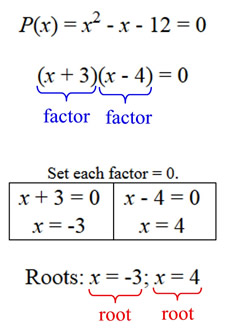
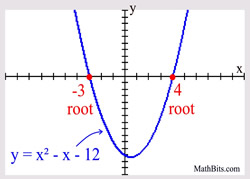 Zeros (roots): (-3,0) and (4,0).
If x = 0, then y = -12.
Zeros (roots): (-3,0) and (4,0).
If x = 0, then y = -12.
So, the point (0,-12) is on the graph.
and the graph opens "up".
|
 Note: A polynomial of degree 2 (a quadratic) will usually have two distinct roots (zeros). When graphed, the shape of the graph resembles the letter U (either up-right or up-side-down). Finding the y-intercept (where x = 0) will show if the graph opens "up" or opens "down". Such a graph is called a parabola. Note: A polynomial of degree 2 (a quadratic) will usually have two distinct roots (zeros). When graphed, the shape of the graph resembles the letter U (either up-right or up-side-down). Finding the y-intercept (where x = 0) will show if the graph opens "up" or opens "down". Such a graph is called a parabola. |

Zeros (roots) are where the graph crosses the x-axis.

What happens when a factor repeats?
Consider the example below at the left. The polynomial function is of degree two, so there will be two zeros (roots). The factor of (x + 3), however, is repeated (giving the factors as
(x + 3)(x + 3)) yielding only one numeric root. This graph will only touch (be tangent to) the x-axis at x = -3 or at (-3,0).
Consider the example below at the right. This polynomial function is of degree three, so there will be three zeros (roots). The factor of (x - 1), however, is repeated three times. Again, we only have one numeric root for the graph. This time the graph passes through the point (1,0). |
Quadratic
Example degree 2:
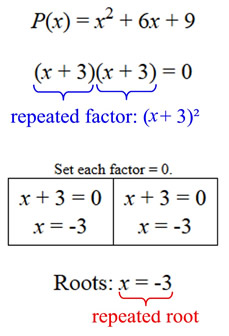 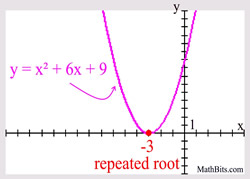 Zero: (-3,0)
Testing the y-intercept gives the point (0,9).
Zero: (-3,0)
Testing the y-intercept gives the point (0,9).
Testing a point to the left of -3 gives (-6,9).
Graph opens "up".
|
Cubic
Example degree 3:

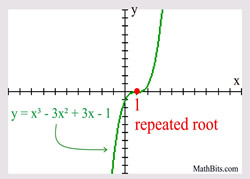 Zero: (1,0)
Testing points to the left and right of the zero x = 1
Zero: (1,0)
Testing points to the left and right of the zero x = 1
helps determine the graph (such as (2,1) and (0,-1)). |
 Note: A polynomial of degree 3 (a cubic) may have 1, 2 or 3 distinct zeros (roots). The shape of the graph may vary, but will usually have two turning point (hills or valleys). Finding points surrounding the zeros will help determine the shape of the graph. Note: A polynomial of degree 3 (a cubic) may have 1, 2 or 3 distinct zeros (roots). The shape of the graph may vary, but will usually have two turning point (hills or valleys). Finding points surrounding the zeros will help determine the shape of the graph. |
 |
|

The graphing calculator can prove to be helpful for checking your answer when factoring and graphing. |
|
For help with factoring on your calculator,
Click Here!
|
|
|

NOTE: The re-posting of materials (in part or whole) from this site to the Internet
is copyright violation
and is not considered "fair use" for educators. Please read the "Terms of Use". |
|